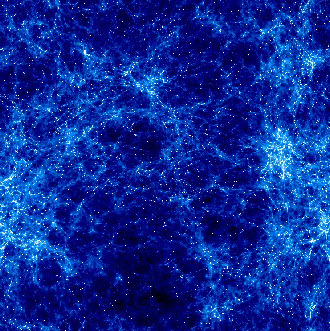

science
Please mouseover difficult words to see what they mean
University of Durham. Eurekalert. 13-
Was it warm or was it cold?
Scientists shed new light on how stars were born in the early universe, 13 billion years ago.
The birth of the first stars depends on the nature of ‘dark matter’, cosmologists at Durham University say. This is the mysterious material that contains most of the mass of the universe. Their results are published this week in the journal Science.
The discovery takes us another step towards understanding dark matter. This has been pretty much of a mystery since it was first detected more than 70 years ago. The new discovery also suggests that some of the very first stars that ever formed are still around today.
Even although nobody knows what dark matter is, the evidence that it exists is very strong. This evidence comes from observations of the motions of galaxies and clusters of galaxies, and of the behaviour of the universe as a whole.
Just after the Big Bang there were no stars or planets. The universe was mostly ‘smooth’, with small ripples where matter had gathered together just a little. Gradually gravitational forces on the dark matter in these ripples made them grow, slowly gathering more matter into great clumps that became the first stars.
This happened about 100 million years after the Big Bang.
In their research the team at Durham University’s Institute for Computational Cosmology carried out detailed computer simulations. They studied the birth of the first stars using accepted scientific models of ‘cold’ and of ‘warm’ dark matter.
The results showed that if dark matter is cold and slow-
On the other hand if dark matter is warmer and faster-
These filaments would have been around 9000 light years long, says Dr Liang Gao. This is about a quarter of the size of the Milky Way today. "The very luminous star burst would have lit-
Stars forming in cold dark matter are very massive. The larger a star is, the shorter is its lifetime. So these large stars would not still be around today.
But with warm dark matter, the new research shows, low mass stars would have been born as well as large ones. Low mass stars have very long lives. So some of these first stars in the universe would still be around today, the scientists say.
This result paves the way for research that could bring us closer to learning just what dark matter is.
A key question astronomers often ask is ‘where are the descendants of the first stars today’, says Dr Tom Theuns. "The answer is that, if the dark matter is warm, some of these primordial stars should be lurking around our galaxy.”
The Durham University scientists' work sheds new light too on how black holes could form. Monster black holes are at the centre of most galaxies. Some of these black holes have a mass more than a billion times the mass of our sun.
Seeds for such black holes are created by collisions between stars in the dense filament in the warm dark matter scenario.
These results raise the exciting possibility of learning about the nature of dark matter from studying the oldest stars, says Dr Theuns. "Another tell-
"They could have formed during the collapse of the first filaments in a universe dominated by warm dark matter.”
More help with words
galaxy
gravity
matter
model
planets
orbit
universe
What's it all about?
